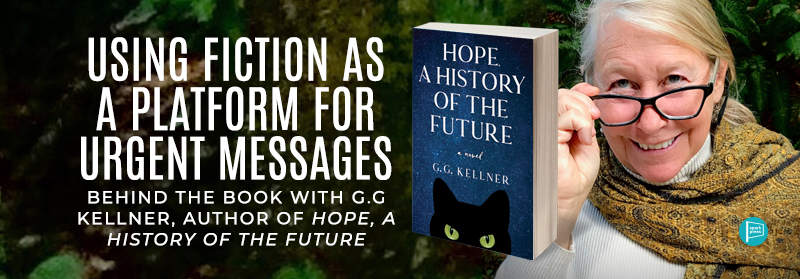
I wanted to bring readers a message about both the urgency of the climate crises as well as possible solutions. Sometimes, it is easier for people to grapple with difficult messages when it is presented in the form of a story. Fiction, this type of storytelling, can be used effectively to build awareness around important issues.
I felt strongly that the world needed a story of hope and possibility out of the many current world crises, particularly the climate crises. So, I quit my day job and moved to a small cabin on a remote island. With only an outhouse and woodstove, I wrote the first draft of Hope, A History of the Future.
Hope, A History of the Future is a fictional story, but it is based in scientific possibility and historical precedence sighted in the back of the book. The story carries the reader beyond the horizon of environmental catastrophe and offers hope in this time of despair. In the book, various members of the Denzell family explore a history book from the future that has fallen out of time and space and into their home. They gradually uncover, with the help of a mystical cat, the story of Gabe, Mia, Ruth, and a girl without a name. Hope, A History of the Future chronicles the rise of a peaceful, just, verdant world following an environmental collapse of the world as it is now, and asks the question—“Could we avoid this breakdown and build such a society by acting now?”
But before I started writing, I thought about my intended audience. I thought about everyone. Okay, everyone is too big of a category. Everyone is not going to read any book, but I knew I wanted to target a large diverse group of ages and interests. I wanted to write a story that would appeal to a lot of people. I thought about the kind of stores people like: People like animals. People like magic. People like romance. People like mystery. People like adventure. And most of all, people like to be entertained.
So, Hope, A History of the Future has a cat, Plato. He is a main character that weaves throughout the book. He is the trickster in the story who holds his tail in the shape of a question mark. He helps to soften the hard parts of the story. People need help with hard messages, so it is especially important to add levity when dealing with difficult topics.
Plato has magical qualities as well. So does the history book from the future. I paired Plato with the magical history book that falls out of time and place and into the home of the Denzell family home, because that allowed me, as a writer, to tell the difficult parts of the story through the telescope of time. So, the Denzell family are reading about what happened and how humanity responded to the climate crises instead of what is happening.
The magical elements in Hope, A History of the Future also allowed me to write more than one outcome. I am currently working on the sequel, which imagines how we create a peaceful, just, verdant future without going through a collapse; saving ourselves and our world by responding in timely manner to the climate emergency.
People like romance, so Hope, A History of the Future has a little romance to make it more fun. Two of the main characters are a young couple in love who decide to perform their own wedding ceremony on the eve of their departure from a collapsing city. I invented a new kind of marriage, a moon marriage, an unofficial marriage counted in moon cycles instead of years.
Since people like mystery, I made sure as I wrote Hope, A History of the Future to end each chapter with a cliff hanger. And I sprinkled big and small mysteries throughout. For example, the little girl in the story doesn’t remember her name. You’ll have to read the story to find out what it is. It is finally revealed near the end!
People love adventure. So, Hope, A History of the Future is packed full of adventure, from sailing on the open sea, to surviving on a deserted island.
I knew I wouldn’t reach everyone, but I targeted my writing to readers aged 16 to 116—thus I decided to make my characters diverse in age, from wise and slightly crotchety 60+ Aunt Ruth, to Grace, age 10, the youngest of the Denzell family, to her siblings Kate and Zen as high school students beginning to worry about their future. I also included an older brother Samuel, a college graduate questing for meaningful work.
I kept the book intentionally short. I kept the language interesting but accessible–– I did not what to write War and Peaceor a Pulitzer Prize winner. I also wanted to reach out to readers who might not already be aware of the seriousness of the climate crisis. So, I wrote characters into the Hope, A History of the Future that held different viewpoints from my own. For example, my character Joyce is religious, and Mia’s father is a climate denier.
Hope, A History of the Future is fictional, but I wanted to share factual information, so in the back matter I included actual historical photos and documents that support the rise of a peaceful future world.
Fiction can be a very important way of sharing urgent messaging. Let me know what you end up writing about. I love to learn new things.
Find G.G. Kellner on Social Media:
https://hopeahistoryofthefuture.com/
Instagram: @hope_a_history_of_the_future
Facebook: https://web.facebook.com/hopeahistoryofthefuture
Twitter: @GGKellner
TikTok: @GGKellner

Leave A Comment